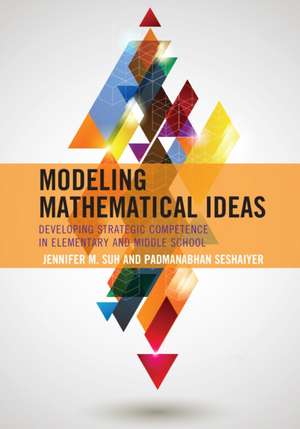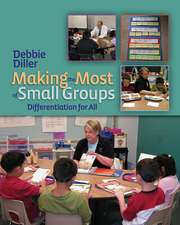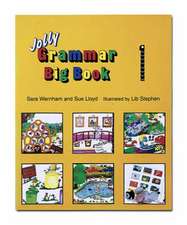Modeling Mathematical Ideas
Autor Jennifer M. Suh, Padmanabhan Seshaiyeren Limba Engleză Paperback – 23 dec 2016
Modeling Mathematical Ideas combines current research and practical strategies to build teachers and students strategic competence in problem solving. This informative book supports teachers in understanding learning progressions that address conceptual guiding posts, as well as students common misconceptions, in investigating and discussing important mathematical ideas related to number sense, computational fluency, algebraic thinking and proportional reasoning. In each chapter, the authors opens with a rich real-world mathematical problem and presents classroom strategies (such as visible thinking strategies
| Toate formatele și edițiile | Preț | Express |
|---|---|---|
| Paperback (1) | 452.49 lei 6-8 săpt. | |
| Rowman & Littlefield – 23 dec 2016 | 452.49 lei 6-8 săpt. | |
| Hardback (1) | 685.34 lei 6-8 săpt. | |
| Rowman & Littlefield – mar 2017 | 685.34 lei 6-8 săpt. |
Preț: 452.49 lei
Nou
Puncte Express: 679
Preț estimativ în valută:
86.59€ • 92.59$ • 72.19£
86.59€ • 92.59$ • 72.19£
Carte tipărită la comandă
Livrare economică 18 aprilie-02 mai
Preluare comenzi: 021 569.72.76
Specificații
ISBN-13: 9781475817591
ISBN-10: 1475817592
Pagini: 220
Dimensiuni: 178 x 254 x 13 mm
Greutate: 0.45 kg
Editura: Rowman & Littlefield
ISBN-10: 1475817592
Pagini: 220
Dimensiuni: 178 x 254 x 13 mm
Greutate: 0.45 kg
Editura: Rowman & Littlefield
Notă biografică
Cuprins
Chapter 1: Developing Strategic Competence through Modeling Mathematical Ideas
1.1 Developing Strategic Competence through Modeling Mathematical Ideas
1.2 Promoting Math Proficiency and Mathematical Practices
1.3 Problem Solving and Mathematical Modeling in the Elementary and Middle Grades
1.4 Multiple Representations and Strategies as Tools to Cultivate Visible Thinking in Mathematics
1.5 Importance of Understanding the Vertical Learning Progression to Deepen Students¿ Mathematical Understanding
1.6 Technology Integration in Problem Solving
1.7 More Related Rich Problems to Explore
Chapter 2: Setting Math Norms to Promote Math Reasoning and Modeling
2. 1 Developing Persistent Problem Solvers with a Productive Disposition towards Math
2.2 Unpacking the Mathematics for Deeper Conceptual Learning
2.3 Choosing Worthwhile Tasks through Cognitive Demand Analysis
2.4 Promoting the Core Teaching Practices through Research Lessons
2.5 Integration Technology and Connecting to the Learning Progression
2.6 Assessing Students Understanding through a Problem-based Task
Chapter 3: Engaging in Mathematical Modeling in the Elementary and Middle Grades
3.1 Math Modeling in the Elementary and Middle Grades: What are the building blocks?
3.2 Mathematical Modeling through Unstructured Real-World Problems
3.3. Lesson Study Focus on the Mathematical Modeling: Traffic Jam
3.4 Promoting the 21st Century Skills
3.5 Technology Integration in Problem Posing and Problem Solving
3.6 A Related Rich Problem to Explore
Chapter 4: Modeling Math Ideas with Numbers and Operations
4.1 Lesson Study Vignette: Prime and Composite Numbers
4.2 Visible Thinking in Math: Using Multiple Representations
4.3 Zooming in on the Learning Progression of Numbers and Operations
4.4 Teaching Strategies: Using Math Happenings
4.5 Connecting Procedural Fluency and Conceptual Understanding
4.6 Technology Integration in Problem Solving
4.7 More Related Rich Problems to Explore
Chapter 5: Modeling Math Ideas with Patterns & Algebraic Reasoning
5.1 Lesson Study Vignette - Growing Staircase problem
5.2 Visible Thinking in Math: Using a Modeling Math Mat
5.3 Patterns and Algebra: Zooming in on the Learning Progressions
5.4 Teaching Strategies: Promoting the Algebraic Habits of Mind
5.5 Lesson Vignette: What Would You Choose? Analyzing Change in Number Patterns
5.6 Technology Integration in Problem Solving
5.7 More Related Rich Problems to Explore
Chapter 6: Modeling Math Ideas with Equations and Inequalities
6.1 Lesson Study Vignette: Setting a Math Learning Agenda
6.2 Zooming in on the Learning Progressions for Algebra
6.3 Visible Thinking in Math: Naming, Sequencing and Connecting Math Strategies
6.4 Teaching Strategies: Using Misconceptions to Repair Understanding &Looking for Efficiency
6.5 Technology Integration in Problem Solving
6.6 More Related Rich Problems to Explore
Chapter 7: Modeling Math Ideas with Fractions
7.1 Lesson Study Vignette: The Unusual Baker
7.2 Visible Thinking in Math: Assessing Student Learning through Classroom Artifacts
7.3 Zooming in on the Learning Progressions: Fractions
7.4 Implementing mathematical tasks that promote reasoning and problem solving
7.5 Teaching Strategies, Using Representations and Overcoming Common Misconception
7.6 Technology Integration in Problem Solving
7.7 More Related Rich Problems to Explore
Chapter 8: Modeling Math Ideas with Fraction Computation
8.1 Lesson Study Vignette: Stuffed with Pizza- Adding fractions
8.2 Visible Learning in Math- Using Tools to Prove their Thinking
8.3 Learning Progression in Fraction Operations
8.4 Lesson Study Vignette: Share My Candy
8.5 Teaching Strategies: Strategy mapping on the board plan
8.6 Use of students¿ diversity of strategies as pedagogical content tools
8.7 Technology Integration in Problem Solving
8.8 More Related Rich Problems to Explore
Chapter 9: Modeling Math Ideas with Ratio and Proportional Reasoning
9.1 Lesson Study Vignette: The Leaky Bathtub
9.2 Zooming in on the Learning Progressions on Proportional Reasoning
9.3 Visible Thinking in Math: Using Representational models for proportional reasoning
9.4 Lesson study vignette: The Cathedral Problem
9.5 Deepening Teacher Knowledge and their Strategic Competence
9.6 Promoting Reasoning to Rich tasks
9.7 Technology Integration in Problem Solving
9.8 More Related Rich Problems to Explore
Chapter 10: Pulling it all Together: Strengthening Strategic Competence through Modeling Mathematics Ideas
10.1 Practice-based Activities to Focus on Models and Modeling within our Standards
10.2 Modeling Math with Tools and Representations
10.3 Understanding Conceptual and Interpretative Models of Math Ideas
10.4 Modeling Math through Problem Solving and Problem Posing Tasks
10.5 Mathematical Modeling through Unstructured Real-World Problems
10.6 Strengthening Strategic Competence for Modeling Mathematical Ideas
Appendix
References
Descriere
Modeling Mathematical Ideas will provide a guide for navigating through the mathematics learning progressions for number sense, computational fluency, algebraic thinking and proportional reasoning through meaningful conceptual tasks.









